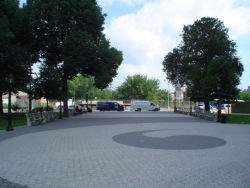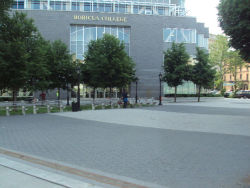O'Neill Triangle
O’Neill Triangle
The identity of O’Neill Triangle’s namesake is something of a mystery. The Board of Aldermen named it O’Neill Square in 1940, stating they were naming it after “a World War I hero named O’Neill.” However, they mentioned no first name. Records list more than a dozen New York residents named O’Neill who fought in World War I, but none of them was from the Bronx. Starting in the early 1930s, the City named many parks after World War I veterans without regard to where they grew up. Historians offer several possibilities of who the unknown veteran was: Private Lewis E.G. O’Neill, who died of war wounds in November of 1918; Sergeant Richard W. O’Neil, of the 165th Infantry; or Corporal Alfred H. O’Neil, also of the 165th Infantry. Others suggest that it was named after Patrick J. O’Neil, a realtor and major local figure in the Democratic Party. The park was renamed O’Neill Triangle in 1997 because it has three sides.
O’Neill Triangle is bordered by Elton Avenue, East 161st St., and Washington Avenue. Tracks from the old New York and Harlem Railroad run underneath the park. It lies in the neighborhood of Morrisania, originally the estate of the Morris family, one of the early, aristocratic families to inhabit the Bronx. The most famous Morris was Gouverneur Morris (1752-1816), one of the leading American politicians during and after the American Revolution. Witty and urbane, his greatest achievement was to write the final draft of the Constitution, giving the document its coherent form and elegant language.
Aside from politics, his pride and joy was his estate, Morrisania. At the time, Morrisania was a gentleman’s farm in the country, far away from the noise and bustle of New York City, which then inhabited only the southern tip of Manhattan. Morris spent much of his later years making improvements to the estate and building and rebuilding his mansion to fit his aristocratic tastes. The estate was a haven from the world, in the same mode as Thomas Jefferson’s Monticello or George Washington’s Mount Vernon. However, unlike those domiciles, Morrisania did not survive. In 1848, Gouverneur Morris Jr. sold the estate to a developer, who converted it into Morrisania Village. The village expanded to become the town of Morrisania, and in 1874 it was annexed by New York City as part of the 23rd ward.
In the early part of 2000, Parks completed a $52,126 reconstruction of O’Neill Triangle, funded by Mayor Rudolph W. Giuliani. The renovation refurbished the asphalt pavements, paths, and playing surfaces, concrete sidewalks and pavements, tennis and basketball court surfaces, and chain link fences. It also included general site work, such as bench repair, flagpoles, drinking fountains, painting and landscape restoration work. This work was carried out as part of the Greenstreets program. Begun in 1986 and revived in 1994, Greenstreets is a program of Parks and Transportation funded through Parks’ capital budget that plants trees and shrubs in some of the smaller city parks and squares. O’Neill Triangle remains a small green haven in the midst of a busy city, reminiscent of this neighborhood’s historic past.
Check out your park's Vital Signs
Clean & Safe
Green & Resilient
Empowered & Engaged Users
Share your feedback or learn more about how this park is part of a
Vital Park System



